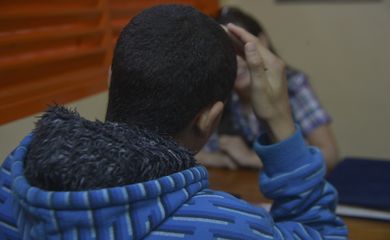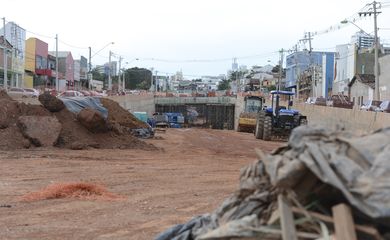Belo Horizonte works to stop racism inside and outside football field




The problem of racism in football was brought under the spotlight in February this year after the incident with Tinga, a midfielder for Cruzeiro, a team from Belo Horizonte, Minas Gerais, who was the target of racial abuse from Real Garcilaso fans during a Copa Libertadores match in Huancayo, Peru.
Brazil is expected to take the opportunity of hosting the 2014 FIFA World Cup to discuss the subject of racism. For Minister of the Secretariat for Racial Equality Luiza Bairros, it is important to discuss racist behavior in football, but one should not neglect the issue outside the stadiums.
“We must make clear that racism in football is the expression of racism in society at large. There has been a general increase in cases, and not just in the sport,” she noted, and added, “Now, as regards the World Cup, I believe we can take this opportunity to help raise people’s awareness about the need to repudiate any sort of discrimination against black people.”

In Belo Horizonte, African-Brazilians amount to 52.7% of the population. This figure is above the national average – 50.7%.
The problem of racism in football was brought under the spotlight in February this year after the incident with Tinga, a midfielder for Cruzeiro, a football team from Belo Horizonte, Minas Gerais. He was the target of racial abuse from Real Garcilaso fans, during a Copa Libertadores match in Huancayo, Peru.
Tinga received support from all sides – fans of the opposing team included. Marcelinho Conceição, director for events of Atlético Mineiro’s fan club, argues that rivalry should be restricted the football field.
“We paid a tribute to Tinga, with the topic ‘yes to rivalry, no to racism’. We’re the country with the largest number of people of African descent outside Africa.”
Tinga says he had never been the victim of racist behavior in a football field before, even when he was playing in Europe and Japan, places with a history of xenophobia. After the episode, he proposed the further promotion of dialogue in an attempt to attain full equality in society through education.
“It won’t get any better until we address these topics at school, the basis of education, because what we do today is a reflection of what we learn as a child and teenager,” Tinga declared.
“In Belo Horizonte, African-Brazilians amount to 52.7% of the population. This figure is above the national average – 50.7%, according to the official 2010 census. Belo Horizonte’s Coordinator for Racial Equality Rosângela da Silva points out that the problem is deeply ingrained in Brazilian society, and comes to the fore whenever stories like the Tinga episode hit the headlines.

Rosa Vani Pereira, an official from the city’s Secretariat of Education, explains that considerable progress was made in the public schools of Belo Horizonte with the distribution of African-Brazilian literature books.
“What is the image we would recognize on history books in the 80’s and 90’s? It's the image of a black man tied up, alongside an Indian who's too lazy to work. And this also aroused a feeling of self-negation among African-Brazilians themselves. Today, we have a federal law on the teaching of African history at schools, which is a real breakthrough when we bear in mind the fight against racism.”
Rosa Vani Pereira, an official from the city’s Secretariat of Education, explains that considerable progress was made in the public schools of Belo Horizonte with the distribution of African-Brazilian literature books.
“Before that, whenever we talked about Africa as part of the curriculum, you could either refer to the Africa of Tarzan or the Africa of extreme poverty. There was no alternative.”
The Secretariat of Education has also promoted the African-Brazilian Exhibit, which features, among other things, workshops and films targeted at students and teachers.
Another pioneering initiative launched in the city was the creation in November 2013 of the Help Center for Victims of Racism and Intolerance. The organization was designed to meet the demands made by locals and follow police investigations in order to avoid stagnation in the development of the cases.
Nonetheless, in spite of all the anti-prejudice initiatives, institutional racism is still part and parcel of the country’s reality. During the protests staged in June last year, the Popular Committee of People Affected by the World Cup (“Copac”) reported a number of acts of racial abuse. One of the people arrested during the demonstrations was plastic artist Ameba, who spent a month in prison. He says that 15 people were taken to jail and forced to strip naked, kneel, wear handcuffs, and have their heads shaved.

One of the people arrested during the demonstrations was plastic artist Ameba. He spent a month in prison, and says that 15 people were taken to jail and forced to strip naked, kneel, wear handcuffs and have their heads shaved.
“There was a black guy sporting dreadlocks. They cut off his dreadlocks with a knife. Not only is that extremely disrespectful, that’s also a violation of one’s identity.”
Rosa Vani points out that racist behavior can be seen all the time throughout the country andt that it translates into an increasingly wider gap between the number of black youths murdered and white ones.
“That’s when I feel most deeply concerned. When I look at the Violence Map of Brazil, I don’t see a huge amount of black boys killed because they’re fat, [for instance.] They’re being killed merely because they’re black.”
For Tinga, the long-term solution to prejudice lies in education:
“I’m not the right person to say what the school curriculum should cover, but there are so many topics we learn about that it takes so long before we actually use, that I believe there could be a school subject – citizenship, or humanity – in which people would be allowed to talk about anything, like prejudice based on religion, sexual orientation, everything. It would simply raise awareness. I believe schools should have that.”
Coordinator for Racial Equality Rosângela da Silva agrees that education is the way to equality: "In and out of the World Cup, among football players, at school, in any measure against racism, the basis for this action lies in education. So I don’t believe in any assertive action for the promotion of racial equality that doesn’t require this specific way of thinking, this reasoning, i.e., the education of an individual.”
Translated by Fabrício Ferreira
Fonte: Belo Horizonte works to stop racism inside and outside football field







